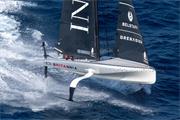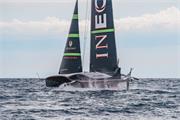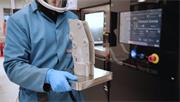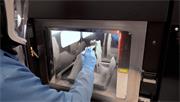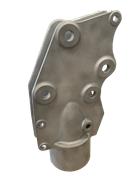INEOS Britannia - sailing towards a sustainable future with AM
Renishaw, the global engineering company, is an official technical partner of the British sailing team, INEOS Britannia, which is the Challenger of Record for the 37th America's Cup.
Led by former Olympic champion Sir Ben Ainslie, the team will attempt to become the first British yacht to win the America's Cup in its 173-year history. The competition takes place in Barcelona, Spain, between August and October 2024.
Renishaw has supported the British challenger for the America's Cup since 2016. For the current campaign, Renishaw supplies INEOS Britannia with magnetic encoder solutions and additively manufactured parts, plus expertise in position measurement and Raman spectroscopy.
INEOS Britannia's mission is not only about winning the America's Cup. It's also about ensuring sustainability in everything they do.
Class Rule
The AC75 Class Rule governs the design and manufacturing requirements for the AC75 Class Yacht used by all competitors in the 37th America's Cup. It includes permission to only build a single AC75 boat, rule incentives for sustainability initiatives in construction of the hull (e.g. using composite recycling), and limitations on the quantity of foils and componentry in the yacht design.
Achieving net zero
INEOS Britannia is part of the broader INEOS Group, which has committed to achieving net zero emissions by 2050. For the current campaign, the team has employed several key strategies to reduce the carbon footprint associated with race yacht manufacturing.
Reducing weight
Reduced package weight can save both material costs and improve the environmental footprint associated with component manufacturing. Advanced composites are widely used on the AC75 Class boats to minimise weight. Renishaw has supplied INEOS Britannia with custom-designed rotary sensors (twist grips), featuring built-in magnetic encoders, that have been integrated into the race boat's helm controls.
These sensors are smaller and lighter than in previous campaigns due to electronic improvements that miniaturise the encoder - minimising the space needed for the helm and flight controls and enabling better ergonomics for the sailors.
Recycled carbon fibre
Carbon fibre is commonly used in sailing due to its exceptional strength-to-weight ratio; INEOS Britannia has manufactured both the hull and sails of the race boat Britannia from carbon fibre.
INEOS Britannia has reduced its consumption of new carbon fibre by incorporating recycled carbon from the British-based recovery plant, GEN2 Carbon Fibre. This material has been used to make hull and deck moulds. The team has also partnered with Ocean Republic to give a second life to its carbon fibre sails. By repurposing the sails, approximately 17 tonnes of CO2e are saved. This commitment to circularity ensures that no carbon fibre ends up in landfill after use.
Single sourcing
Some parts on the yacht are common to all the America's Cup teams and have been manufactured by a single suppler. Michel Marie, manufacturing manager for the INEOS Britannia team, says "All the foil arms are of one design and supplied to every team by Persico Marine, so there is a production chain to make them which reduces the environmental impact compared with if every team had to make their own."
The race yacht's mast is also sourced from a single manufacturer common to all teams.
Metal 3D printing
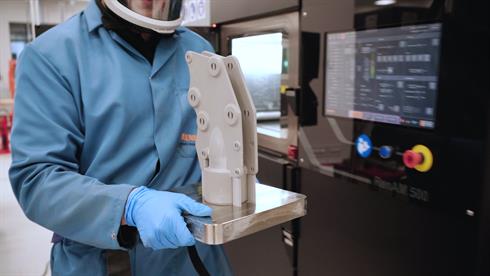
INEOS Britannia uses additive manufacturing (AM) processes to manufacture some metal parts such as the ‘mainsheet sheave end'. AM is a versatile manufacturing technology that allows near-net shape production of a wide variety of complex functional shapes. It offers exciting new design opportunities for combining and optimising parts, potentially reducing tooling and material costs.
In this application, AM can significantly reduce the waste, scrap and embodied carbon* associated with the manufacture of parts, when compared with traditional CNC machining.
INEOS Britannia has used Renishaw's RenAM 500 AM systems to manufacture numerous metal parts on its race and test yachts.
Worked example
To highlight the power of AM techniques to minimise the embodied carbon* of metal parts, Renishaw has performed a like-for-like comparison of CNC machining and AM manufacturing in the production of the mainsheet sheave end for the T6 test boat. The AM process delivers an eight-fold reduction in carbon intensity compared with traditional CNC machining.
A significant contribution to the embodied carbon of the machined part is the energy used for machining and removing a large amount of material . The titanium billet required for the CNC process is 8.5 times more massive than the powder required for the equivalent AM build. In this case, CNC machining generates 19.7 kg of swarf waste material.
These approximate figures account for only principal processes without including finish machining, polishing or heat treatment. Data for machine energy consumption and emissions from power generation are drawn from various sources.
Michel explains how INEOS Britannia champions sustainability across its operations: “The sustainability section of the class rule is based on a series of initiatives with the aim of reducing the carbon footprint of manufacturing of the yacht. It is mainly focused on composite manufacturing.
These initiatives have been established based on lifecycle assessment work done a few years back when the class rule was written. What the LCA showed was that half the footprint of a new yacht is embedded in the manufacturing of the moulds. Following this were a series of initiatives for reducing the impact of manufacturing the mould. These initiatives have been designed not to reduce the mechanical performance of the actual yacht. Overall, the carbon footprint of the manufacturing of the yacht is reduced by these initiatives.
The class rule is over five years old now and in future it will address the carbon footprint of the entire campaign – not only the composite manufacturing.
And as part of that overall footprint, we will be looking at manufacturing all the other mechanical components which make the yacht. At INEOS Britannia, we've already done an LCA study of the entire campaign including all the team operational activities. We have also completed a detailed assessment of the footprint of launching the yacht that includes building the composite hull structure, but also building the sails, all the electronics, the metal parts, and the foils. These show that composites only represent a small portion of the overall footprint.
In the manufacturing of the metal components, 3D metal printing can offer a lower carbon footprint than traditional CNC machining where you might take a big billet of titanium, for example, and turn it into a relatively small part. Renishaw's AM manufacturing expertise has helped us to reduce the overall carbon footprint of the entire yacht.”
Summary
INEOS Britannia's commitment to sustainability is as impressive as its challenge of winning the America's Cup. By combining advanced technologies with innovative practices, the team has managed to reduce its environmental impact while still achieving high performance on the water. The use of recycled materials, additive manufacturing, and single-source components leveraging production chains demonstrates a forward-thinking approach that sets a benchmark for the sailing industry. Technical partners such as Renishaw have helped INEOS Britannia to achieve its sustainability goals — setting sail for a greener future.



